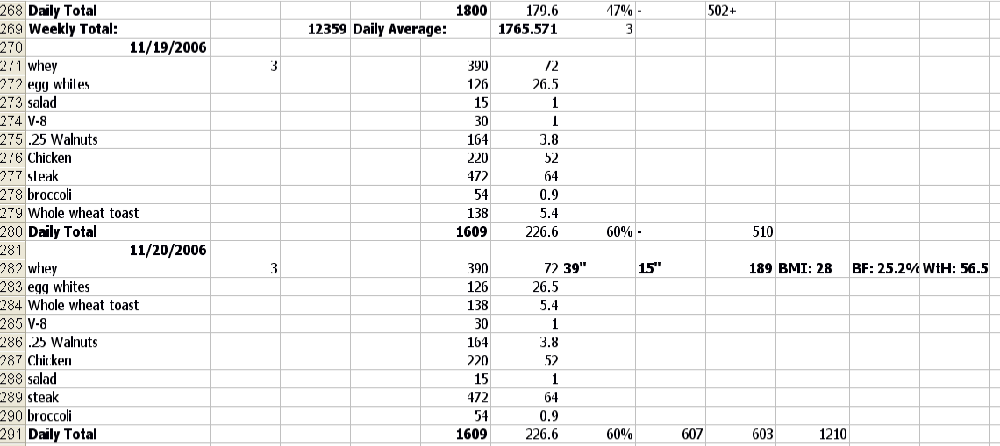It is very well known that in order to lose weight, you must burn more calories than you consume, therefore you must track your eating. Otherwise, how would you know how many calories do you consume each day? Simply guesstimate? If so, then that is simply not adequate. When you take the first step to lose weight, you must get a handle on your eating, period. It is impossible for most people to keep track of all this in their head. Therefore you must have a journal so that you can track your eating. One of the earliest things I did was create an Excel spreadsheet that I used to track what I ate on a daily basis. Why would I do this? First, I needed to get an idea of how much I was eating currently. Without knowing, I had no basis to cut calories. But once I started, I learned quickly how much I ate. I had always thought I was doing an okay job, but seeing the daily caloric values, I was shocked how much calories I consumed each day. On the flipside, I was able to see where I could cut back without adversely affecting my health. When you track your eating, you too can use this as a basis to adjust your eating habits.
Now that you decided to track your eating, how do you go about doing it? I know of people who use a notebook, and they write down what they ate and kept track that way. Others bought software that has huge databases of all foods - including meals from popular restaurants. You simply select what you ate, and the program calculates not only your calories, some programs even provide you nutritional information as well. There are web-based tools that do the same. I simply decided to use a spreadsheet. Using the food labels, I would enter what I ate, how much calories it contained, and since I wanted to track protein, I entered the grams of protein contained. Using Excel's auto sum feature, I would total the amount of calories and protein. Whenever I ate at a restaurant, this website to keep track. It contains entrees for many, many restaurants. In the, rare, cases I could not find the restaurant, I used this rule of thumb to estimate my calories. Carbohydrates and proteins have 4 calories per gram; fats have nine calories per gram. I simply made rough estimates and since this situation did not happen enough, I was not overly concerned. Once I started tracking, I discovered this was an excellent accountability tool. Because I was very strict about putting everything I ate, I always had the log in the back of my mind. I would hesitate to sneak, because I had to place it in my log and see the daily caloric intake rise. I did allow myself once a week to enjoy my favorite foods - I called it my "free day", a day I did not track what I ate. You know, in spite of eating very liberally on my free day, and I mean extremely liberally, I still ended up losing six pounds a week. Because I ramped my water consumption to about 96 to 120 ounces a day, it clearly was not water weight. As time progressed, I used this log to track my weight, and eventually I would track my waist size, body fat composition, my basal metabolic rate, and my estimated calories I burned from my physical training.
Tracking what I eat was instrumental in my weight loss, and remains a valuable tool to this day. Take control over your weight - begin by tracking your eating. You will be surprised and pleased by the outcome!

This is an excerpt from my Excel spreadsheet that journals my eating. On a daily basis I track calories and protein, as well as calories burnt from my training. Weekly I track weight, waist measurement, body fat percent, and waist-to-height ratio. Tracking your eating manually can be very tedious even using the spreadsheet. I found a program here that can do all that track your eating very easily; its try before you buy and only costs $25.

